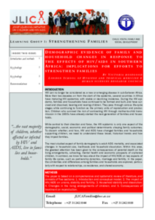HIV can no longer be considered as a new or emerging disease in sub-Saharan Africa. More than two decades on from the start of the epidemic, several countries in Africa have maturing HIV epidemics with stable or declining incidence. During the HIV epidemic, families and households have continued to be formed and built, and have survived and dissolved, bearing and rearing children. They pass through various life-cycle stages while continuing to function as the primary units of reproduction and production.
Children who survived the risk of contracting HIV through mother-to-child transmission in the 1980s have already started the next generation of families and households. While central to their direction and force, the HIV epidemic is only one aspect of the demographic, social, economic and political determinants shaping family outcomes. To discern whether, and how, HIV and AIDS have changed families and households supporting children, we need to understand these broad, historical trends and how they impact families.
The most studied aspect of family demography is adult AIDS mortality, and associated changes in household size, livelihoods and household dissolution. Within this area, the greatest attention has been given to the consequences of parental death on the living arrangements, schooling, mental health and economic prospects of orphaned children. Orphaning is increasing throughout the region as HIV epidemics mature and adult deaths increase. However, single-parent and double orphans are a minority of all children even in countries with high HIV prevalence. Furthermore, most orphaned children continue to live with surviving parents, close family and kin.
In contrast, we know far less about the impact of HIV/AIDS on key aspects of family life cycles, such as partnership dynamics, marriage and fertility. Considering that the vast majority of children, whether affected or infected by HIV and AIDS, live in families and households, it’s increasingly important to understand the subsequent dynamics. In the paper, the similarities and differences among families and households are explored, particularly with respect to relationships, co-residence, and shared economy.

